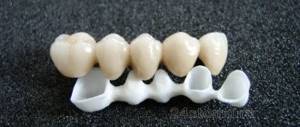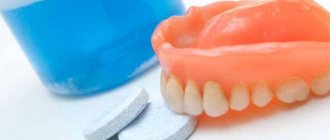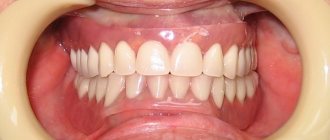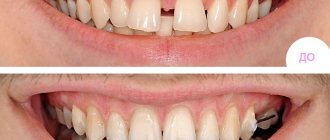Today, metal-ceramics is considered one of the most popular materials for prosthetics in dentistry. Its main advantages are high strength and durability, decent aesthetics and affordable cost. However, in order for prosthetics to be truly durable and reliable, the patient should know how to properly care for metal-ceramic teeth and carry out such care regularly.
How much can you eat after dentures?
After installing permanent crowns or inlays, you can drink water immediately, but eat after 1.5-2 hours. This is not related to the type of prosthesis or the adhesive used for fixation. During treatment, anesthesia is used - and it is very important that its effect wears off completely, otherwise chewing can injure the tongue or the inside of the cheeks.
After installing temporary crowns or inlays, you are allowed to eat food after 2-3 hours. However, in such a situation, it is strongly recommended not to put any stress on the restored tooth and try to chew food on the other side - not only at first, but throughout the entire period of wearing the temporary structure. It is impossible to put a load on such prostheses - they are not designed for it (naturally, if we are talking about crowns or inlays, which are installed for a maximum of 2-3 weeks, and not for a long time).
Stages of prosthetics
In our clinics, it is possible to perform prosthetics with metal-ceramic crowns on a turnkey basis. The process is carried out in several stages:
- examination and diagnosis - identifying problems and their causes, developing a treatment regimen, selecting prostheses;
- treatment – elimination of problems in the oral cavity using therapeutic methods;
- sanitation – cleaning plaque and precise selection of crown shade;
- taking an impression using special materials and tools;
- preparation of the organ - removal of destroyed tissue, removal of the nerve, cleaning of the canal, turning for a tighter fit of the prosthesis. However, complete depulpation is carried out only for organs with a single root system or seriously affected by pulpitis;
- manufacturing, fitting and installation of crowns.
What diet should you follow?
A lot depends on the original condition of the tooth to be restored. So, if the root is strong, approximately half of the tissues of the coronal part are preserved, and the prosthesis itself is installed correctly and professionally, there are no obvious restrictions in terms of load. Stump tabs, which are also used to strengthen the root system, fit very tightly, hold securely and do not require any special changes in nutrition. But if, for example, prosthetics were performed on a pin, the chewing pressure on the tooth must be reduced, since it can lead to displacement of the pin, and subsequently the crown.
In general, recommendations for any type of prosthetics from a nutritional point of view would be as follows:
- limiting the consumption of drinks high in caffeine (tea, coffee) and coloring pigments (wine, beets), especially if you have plastic and metal-plastic crowns that absorb dyes from food and drinks,
- Food that is too cold or too hot should be eaten with great caution - it can lead to cracks and chips of materials, and disruption of their adhesion (fixation). It is also impossible, for example, to immediately drink hot tea after cold ice cream - sudden temperature changes can again provoke the formation of cracks and destruction of dentures, weaken the effect of the fixing adhesive,
- Despite the fairly high strength of crowns and inlays, you need to protect them from excessive loads - it is better to first cut solid food into small pieces,
- teeth with crowns should not be used to open the shells of nuts, such as pistachios,
- If you have dentures, it is recommended to avoid viscous and stringy foods, namely chewing gum and toffees, which can stick to crowns or inlays, and with excessive load and gradual deterioration of the fixation of the prosthesis can lead to its loss.
First of all, crowns that have an external coating that can break off need to be protected from mechanical loads - made of metal-plastic, metal-ceramic or zirconium coated with ceramic.
Is it possible to whiten ceramic crowns and veneers, and what whitening methods does dentistry offer?
Dentures made of ceramics or metal-ceramics do not always satisfy the patient with their quality, since the materials can darken over time and be stained by food, drinks, and tobacco smoke. Either the crown or veneer was initially made darker than desired. A logical question arises: is it possible to whiten ceramic teeth? The answer is not always clear, but there is always a solution to the problem. Read more about this in today's article.
What hygiene products are needed and can be used?
What hygiene products are needed and can be used?
| NAME | DESCRIPTION |
| Toothbrush | The bristles should be soft or medium hard. Too hard ones can damage the material and leave small scratches on it, in which plaque will accumulate. The use of an ultrasonic or mechanical brush is allowed, but it is very important to carefully select attachments - they should not have plastic elements (often used to better clean or whiten teeth). |
| Toothpaste | It is better to use prophylactic toothpaste WITHOUT abrasive substances - they can damage the materials. |
| Irrigator | It will allow you to remove food debris from the interdental spaces, especially if several crowns are installed in a row or dental bridges are present - in such a situation, a stream of water will remove food debris from under the structure. |
| Mouthwash | It should be selected in accordance with existing oral problems - for example, to combat gum inflammation, to strengthen enamel or to prevent plaque accumulation. That is, regardless of whether you have dentures or not. |
Is it possible to whiten with folk remedies?
To make the bleach you will need:
- spoon of soda - 1 tsp;
- milk – 1 tsp;
- 1 egg white;
- a pinch of mint.
Stir all the ingredients and the bleach is ready. The result will pleasantly surprise you after the first cleaning. It is not recommended to get carried away in this way - soda has an irritating effect on the gum mucosa and thins the enamel (we recommend reading: is it possible to brush your teeth with soda?).
More gentle methods to whiten teeth made of metal ceramics: brush them with oils (tea tree, olive). Also popular are “natural toothpastes” made from strawberries, apples, pears and avocados.
How to properly brush teeth with dentures
The presence of crowns, inlays or dental bridges in your mouth should not embarrass you: you need to care for them and all other teeth in the same way as you did before:
- it is necessary to clean the oral cavity of plaque 2 times a day - morning and evening: using a toothbrush, make vertical movements from the gums to the cutting edge of the tooth, you can supplement such procedures with an irrigator,
- After each meal, you must use an irrigator, dental floss and interdental brushes (as indicated and with caution). Or at least rinse your mouth with a special product, or with regular warm water.
In addition to the restored teeth, living teeth and gums remained in the oral cavity. They need to be looked after, otherwise the risk of their premature loss increases. Remember that gum disease is five times more likely to lead to tooth loss than regular tooth decay and its consequences.
Advantages and disadvantages of metal-ceramic crowns.
The main advantage of metal-ceramic crowns is their margin of safety, which is why they are most often installed on teeth that experience the maximum load—the chewing teeth.
Metal-ceramic structures also have a number of disadvantages:
When preparing a tooth for installation of a crown, it will have to be ground, i.e. remove a layer of enamel of such thickness that it will be able to accommodate a layer of metal base and ceramics;
The hardness of ceramics is much higher than even the healthiest teeth, as a result, the teeth on the opposite jaw wear out greatly from contact with metal-ceramic crowns, so it is often necessary to depulp the patient’s healthy teeth;
the porcelain coating of metal-ceramic crowns is fragile and susceptible to chipping when biting something hard;
sometimes the metal frame can be visible under the porcelain surface, then a dark line becomes noticeable along the very edge of the crown (this happens when the gums recede), so it is better to use all-ceramic structures to restore the front teeth.
Can I use dental floss?
If you have any dentures in your mouth, you should either refuse floss completely or use it too carefully. The crowns are fixed in such a way that natural micro-gaps between them are preserved, which require cleansing. However, when flossing, you should not make vertical movements - only horizontal ones. That is, you need to insert the thread not from the cutting edge, gradually moving towards the gums, but place its tip directly into the gap - make several horizontal movements and remove it in a similar way.
Do not use the prosthesis if it has a chip or crack - try to see a doctor as soon as possible to restore the integrity of the crown/inlay or for a prompt replacement. Otherwise, there is a high risk of developing inflammatory processes under the prosthesis.
How to paint metal ceramics
One of the options for lightening fillings and crowns is to stain them. For this purpose, various compositions are used today: liquid enamel, professional dental paints and varnishes. Recently, Dental Paint has gained particular popularity. One of its main advantages is that it allows you to paint even hard-to-reach places, and also successfully solves the problem of darkening of filling materials, crowns and dentures. With its help, you can achieve lightening of up to 10 tones, and at the same time the result will look natural1.
Dental Paint can be used to lighten teeth
However, this method also has one significant drawback - the effect will be short-lived, so the procedure will soon have to be repeated. This method is similar to applying makeup, because the paint will be washed off after the first brushing of your teeth. Yes, and you cannot use such products on an ongoing basis, since this can lead to the destruction of the filling or crown. The materials from which they are made do not absorb paint, so it is impossible to change their color in this way. In such cases, dental experts recommend timely replacement of restorative materials and prostheses.
Is it possible to carry out professional hygiene with crowns?
Both teeth and any dentures require high-quality hygiene. Once or twice a year, have your teeth cleaned with an ultrasound. But Air Flow is prohibited in the presence of multiple crowns, since the drug contains abrasive particles that can damage the smooth surface of the dentures. In such a situation, you should definitely warn the doctor about the presence of crowns or bridges - if there are few of them, you can simply bypass them and carry out Air Flow cleaning in another area.
Can dentures be whitened?
Can ceramic teeth be whitened? Imagine ordinary dishes made of ceramics and glass - these compositions are inert to chemical bleaches, peroxide, vinegar and other acids, and alkalis. After all, even in laboratories, aggressive chemicals are stored in such containers - and the shade of their walls does not change.
Thus, ceramic veneers, crowns, restoration inlays, and bridges cannot be whitened using chemical methods. Or just lighten the surface darkening a little - and then while it is “fresh”. Those. until the dyes and plaque have eaten into the microscopic pores and cracks on the surface of the ceramic. Abrasive pastes will also only remove surface deposits, and can only harm the prosthesis itself - if solid particles scratch the top coating, it will lose its aesthetics even faster.
Is it possible to smoke if you have dentures?
There is no direct ban on smoking, but you need to understand that nicotine leads to the formation of a large amount of plaque - both on real and artificial teeth. It is difficult to remove; the gums also suffer because of it - they do not receive enough nutrients, atrophy and expose the tooth roots. If you can’t quit smoking, then try to at least reduce the number of cigarettes you consume to a minimum, at the same time improve hygiene at home, and also visit a doctor every 2-3 months for comprehensive oral hygiene.
Ultrasonic cleaning and its effectiveness
You can restore the natural whiteness of your smile and lighten artificial crowns a little using the procedure of Prof. hygiene. The method involves cleaning teeth from plaque and deposits, and today various technologies are used for this purpose, including an ultrasonic scaler. This is a hardware technique that involves delivering ultrasonic waves and microvibrations through a special tip, which literally break hardened deposits into tiny particles. At the same time, a jet of water is supplied, which removes dirt and also protects the enamel surface from overheating.
As part of comprehensive hygiene, ultrasonic or laser cleaning is usually combined with sandblasting of enamel using an Air-Flow device. This is a mandatory preventive procedure that should be performed every six months. But here it is worth noting that it will not help whiten either fillings or crowns. Lightening occurs only by removing plaque and deposits.
The photo shows the method of brushing teeth with the Air Flow system.
How do you know when it’s time to change crowns?
Cracks, poor fixation on the tooth, discoloration, discomfort when closing the jaws - all these are reasons to consult a doctor. A crown can fail either after 2-3 years or after 10-15 years - a lot depends on the initial situation, the professionalism of the doctor, the quality of the material, as well as on how the teeth were used. We strongly recommend visiting the dentist 1-2 times a year to examine the oral cavity - the doctor will be able to assess the quality of fixation of the prosthesis and its integrity. This way, you won’t have to guess how long the crowns will last, but will be able to understand exactly when you need to worry about replacing them.
All recommendations boil down to the fact that crowns, inlays and bridges, like living teeth, require regular care and careful treatment. Do not forget that in addition to artificial crowns, living tissues remain in the oral cavity - these are gums and ligaments that hold the root of the tooth. All of them are susceptible to inflammatory processes, which can lead to the loss of the remaining living tooth along with the installed prosthesis.
When should you go to the doctor?
You need to make an appointment with a dentist if the following problems occur:
- The installed structure has lost stability;
- There is an unpleasant odor from the mouth;
- An inflammatory process is observed on the gums, pain is felt;
- The crown is installed incorrectly, causes discomfort to the person, and interferes with other teeth;
- The prosthesis fell out.
In addition, you need to visit the clinic for professional preventive cleaning and crown replacement. The service life of such structures varies between 2-15 years, depending on the material of manufacture and compliance with operating rules. Even if the service life of the crown has not expired, it is better to replace it if the color changes or cracks appear. Do not self-medicate, it is better to consult a specialist!
Whitening pastes
Many people think that they can simply whiten their teeth using a special whitening paste. Here again, the so-called “smoker’s effect” is at work: if you smoke a lot and drink liters of black coffee every day, then perhaps you will see an immediate effect and it will suit you.
But you need to keep in mind that most often whitening toothpastes have a very high RDA index (abrasiveness index). They consist of small granules that literally “scrape off” the surface of the enamel. If you use this paste constantly, you can “acquire” increased sensitivity, erosion or wedge-shaped defects in the enamel. Whitening toothbrushes work on the same principle—mechanical abrasion.
What if you are still not satisfied with your natural teeth color and after professional hygiene you decide to have it whitened at the dentist’s office?
Veneers as the only alternative
It is very difficult to whiten metal-ceramic teeth; ordinary paints, varnishes, and bleaches will not give a long-term positive result. The only reliable option is the installation of veneers.
Veneers are the most aesthetic and fastest method of teeth whitening. If a high-quality installation is carried out, this plate will last at least 15 years, and with professional care it will retain its presentable appearance.
The procedure is carried out quickly, in several visits to the doctor. The patient is given the opportunity to independently choose the color so that the smile looks as natural and natural as possible.
Expensive, but high quality and beautiful!
Still, is bleaching harmful?
The concentration of the whitening agent in various whitening strips and gels for home use is minimal: from 3 to 5%. Therefore, many people think that using them is much safer than whitening teeth in the dentist’s chair with a concentration of 25-40%, albeit one-time. However, this opinion is erroneous: in small concentrations, but long-term exposure is more adverse, since it occurs regularly.
Before whitening, especially if you have sensitive teeth, it is necessary to carry out preparation - remineralization. It will make the enamel resistant to acidic environments - otherwise, bleaching can increase sensitivity or even cause enamel erosion.
When they say that bleaching is dangerous, this is what they mean; but, if you strengthen the enamel, its structure will be strong, and the whitening agent will only destroy the pigment. To do this, the dentist applies a special composition with calcium and fluoride to the teeth and recommends similar home remedies.
Is it possible to lighten metal-ceramic teeth?
https://www.youtube.com/watch?v=H4pN5PnLguc
Metal-ceramics, which is widely used in dental prosthetics, is convenient due to its durability, high strength and natural appearance. But how can you whiten metal-ceramic teeth if your smile leaves much to be desired? Unfortunately, whitening is a procedure that is not available to those with artificial teeth.
The fact is that all teeth whitening products can only affect natural tooth enamel.
Therefore, whitening of metal-ceramic implants will not bring the expected result.
But artificial crowns are not a reason to say goodbye to a natural and snow-white smile forever, especially if prosthetics are only planned, but have not yet been performed.
It is better to whiten a healthy row of teeth in advance. The doctor selects the color of the ceramic to match the natural shade of the teeth.
After polymerization (or simply drying of the metal ceramics), the material becomes unyielding and integral, which means it is no longer possible to influence the shade.
Moreover, this applies to all types of prostheses - any implants are almost impossible to change after installation.
It is for this reason that the dentist usually recommends whitening before the denture procedure. Of course, this will require additional investments, but it will allow the patient to be confident in himself in the future.
In addition, if the implants are already installed, but the chewing teeth are replaced with dentures, and the front teeth remain natural, then it is quite possible to whiten them - the difference between the artificial and the front, natural teeth will be invisible. However, before carrying out the procedure, it is necessary to make sure how invisible the prostheses will be - otherwise the smile will turn out unnatural and “spotty”.
Professional teeth whitening
- Now in any dentistry you will be offered modern methods of teeth whitening, and you just have to decide which one is best for you: laser whitening, oxygen, using trays or light.
- Modern dentistry knows many ways to make your smile snow-white.
- But you should remember that only completely healthy teeth can be whitened, so, first of all, get rid of caries, solve problems with your gums, and then proceed to choosing a whitening method.
In addition, any bleaching has general contraindications:
- pregnancy and breastfeeding;
- age up to 16 years;
- allergy to certain components of bleach;
- wearing braces.
The first sign of a dangerous disease - gingivitis - is bleeding gums. Find out why gums bleed.
You can read how to treat a lump on the gum here.









